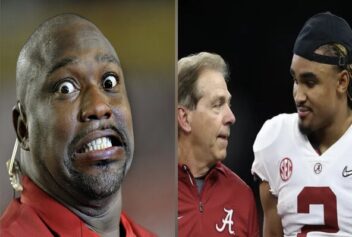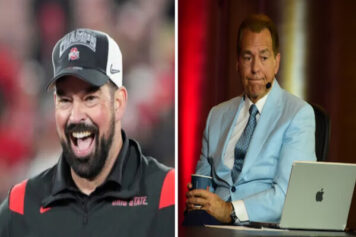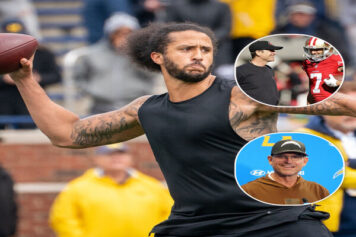I’m a Nick Saban fan, so this ain’t about bashing him or the salary that he earns. And make no mistake about it, he earned every penny of the $11.125 million that he’s slated to rake in this year as the head football coach at the University of Alabama.
Yes, you read that right.
$11.125 million, for this year alone.
Coaches that generate consistent excellence at the highest levels fascinate me. And if you’re one of those morons that just blurted out, “He wins because he has the best players,” please go sit in the corner with a dunce cap on.
The man owns five national championships. Look at what he’s done at Toledo, Michigan State, LSU and now Alabama, and you’ll see that his results are not coincidental. The man is a winner, with a formula that, year in and year out, has the Crimson Tide among the very best and most dominant teams in the country.
If that $11.125 million unnerves you, you don’t have a grasp of the college football economic landscape at the crescendo of the market. I don’t begrudge the man at all for getting what that market dictates.
When you factor in the total compensation that the top college football and basketball coaches receive nowadays, you’re looking in the neighborhood of around $10 million per year.
Saban signed a three-year contract extension that includes a $4 million signing bonus, which was approved earlier this week by the university board of trustees compensation committee.
Altogether, his eight-year deal is scheduled to pay $65 million, not including incentive bonuses. Yes, you read that correctly as well.
Under the terms of Saban’s prior deal, his contract was paying him over $6.9 million annually. That’s a really sweet raise my man just came up on. And don’t think that other deals aren’t coming down the pike with some similar numbers.
Michigan football coach Jim Harbaugh earned $9 million in 2016, $7 million this year and will bring in $7.5 million for the 2018 season. Kentucky mens basketball coach John Calipari made just over $7.1 million this past season. He is set to make $7.45 million in 2017-18 and within two years will be making $8.05 million each season.
And I have absolutely no problem with any of that. If you do, go read Adam Smith’s Bible of classical economics, The Wealth of Nations.
My problem is with the free labor model that allows the NCAA and its elite football and basketball institutions to make so much revenue, without paying those actually produce the proceeds. It’s clear that the players are being pimped. And it’s disgusting in magnitude as the dollar amounts of coaches compensation increase.
We already have a model that needs to be implemented immediately, and it seems to work really well. The very first thing the NCAA should do is look at the Olympics, where athletes are allowed to benefit from their fame and likeness, regardless of whether they are a professional or in high school.
It makes absolutely no sense that Leonard Fournette could not have earned endorsement money during his three years at LSU. He deserved to bathe in that same stream of endorsement money that the coaches, who have deals with food, beverage, footwear and automobile companies, do.
But yet, he would have been vilified if he accepted a car and some cash, or perhaps some free clothes and a tattoo, or god forbid some jewelry and haircuts free of charge.
If the local grocery store chain wanted to pay him to sign autographs for two hours, why is that a problem? My daughter’s friend is a talented teenage musician, and he gets paid a grip to rock out at local gigs. So please tell me how a guy like Fournette’s situation is different?
The restrictions that the NCAA imposes on college athletes and outside earnings is beyond asinine. And it’s morally wrong.
An LSU game jersey that Fournette once wore was purchased for over $100,000 at a charity auction. How much did the school and the NCAA earn with the sales of his #7 jersey?
When I was an undergraduate, we had a department within the business school that helped budding entrepreneurs start their own profitable companies. Most universities have programs that do the same. But let a guy like Fournette license his likeness while piling up touchdowns, yardage and career-threatening wear and tear on his body every week, and he’ll lose his eligibility.
While we work through the complex issues of paying these guys what they’re worth from the school’s standpoint, it’s time to at least open up this revenue stream. If a guy can go get it, go get it. It’s the same way I feel about Saban, Calipari, Coach K, Harbaugh, and others.
But make no mistake about it, paying a coach $11 million a year is not an issue to me. If he can get it, he deserves it. But you can’t tell me that as these salaries escalate, there is something terribly wrong with setting some of that revenue aside for the players who actually are the labor force creating it.
Having this monstrosity of a college sports economy, where the athletes are left out, is not only morally reprehensible, it’s morally unsustainable. It’s time to share a piece of the pie with those who actually bake it.
The inequities faced by college football and mens basketball players, and the exploitation of the players who generate the billions that find their way into other adults’ pockets boggles the mind.
Sports fans are outraged when players like Reggie Bush and Chris Webber get caught up in taking some money while in college. But where is the outrage at the majority of student-athletes, the majority of whom are African-American, that are generating billions of dollars that coaches, universities and companies profit handsomely from, while being openly pimped and earning nothing for themselves.



